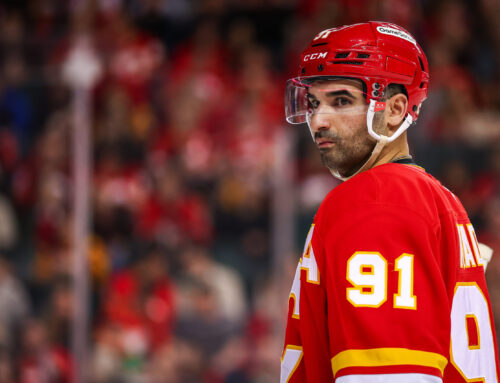With the fantasy trade deadline looming, it’s crucial that you look at more than just overall season statistics to ensure you have a full picture of the player you are acquiring.
One quick way is to look at Dobber’s Hot and Cold Players lists. This will let you know that Brandon Hagel has 20 points in his last 13 games, or that Cale Makar has just one point in his last eight contests.
However, there can be more to analyzing the fantasy impact of a player than just being hot or cold. You need to look at who recently got a promotion to the top line, who has more games at home remaining, or which goalie is getting plenty of starts.
To give you a head start, below are 10 trends for hockey players and teams at this stage of the season.
10. Jonathan Huberdeau Picking Up Points
Don’t look now, but Huberdeau might not be having as disappointing a season as many expect. Sure, his 36 points in 57 games are not ideal, but he’s been great in the year 2024. In his last 22 games, he has 21 points, 29 PIM, seven power-play points and 23 hits. That’s a pretty good stat line, and if he can continue to do that the rest of the year, he would be a sneaky buy-low candidate. His only major downside in these 22 games is his shots, as he has only 32. He’s only averaged 1.6 shots per game in his two seasons with the Flames, so this isn’t unusual.
9. Cole Smith Throwing His Body Around
Each season, there’s an underrated hits person, and right now, that person is Cole Smith. The way he’s piling up hits, he could be a sneaky pickup in deeper leagues, or someone to grab if you’re behind in the hits category. Heading into Sunday night’s action against Nashville, he has nine-straight games with at least two hits. He also has 25 games where he has thrown at least four hits, posting nine in a game just before Christmas. He’s only 17 away from matching his career high. Teammate Jeremy Lauzon is the king of hits (averaging 4.72 hits per game, the fifth-highest mark of the past 15 years), but Smith is still a solid option flying under the radar.
8. Netminders Starting Back-to-Back Games
It used to be that whenever a team played a back-to-back game, the number-one netminder always started the first game, and the backup would get the second game. This increased the odds that the team would get at least one victory in the first game, while it didn’t matter if the backup was thrown behind a tired team. This has been changing lately, and it’s been extremely noticeable these past few weeks. The Canucks, for example, played Casey DeSmith on February 10th against Detroit, while Thatcher Demko played the next day against Washington. One week later, DeSmith started against Minnesota, while Demko got the start the next night. Edmonton has done it in both of their back-to-back games since the All-Star break, with Calvin Pickard starting the first game and Stuart Skinner getting the second. Pittsburgh started the first half of the year in the traditional sense, but has given Tristan Jarry the second game for two of the last three sets of back-to-back games, including this past weekend. Juuse Saros has rested in the first game of three of Nashville’s four sets of back-to-back games this year. Vegas mixes it up. While not all teams are doing this (Dallas, Islanders and Florida being the main ones), and some teams not having a clear-cut top goalie (Boston), it is important to keep an eye on this trend the rest of the way.
7. Philipp Kurashev and Nick Foligno with and without Connor Bedard
I talked about this last week with Kurashev (Top 10 Young Players to Acquire in Keeper Leagues), but it bears repeating: he is a completely different player with Bedard in the lineup. Thanks to various injuries between the two, they haven’t played together as much as you might think. In 38 games together, Kurashev has 26 points, which equates to a 56-point pace. Without Bedard, Kurashev had six points in 14 games, a 35-point pace. Foligno is in the same boat as he also missed games due to injury. He started the season on the top line, was demoted but is now back with Bedard. Since Foligno returned to the lineup, he has played 10 games and has five goals, eight points, 19 shots, three power-play points and 23 hits while playing mostly on that top line.
6. Vincent Trocheck‘s Increased Usage
Up until New Year’s Eve, Trocheck was 16th in the league for average ice time among forwards. He sat at 20:45, 3:34 of which was with the man advantage. Since the calendar switched to 2024, his ice time is at 22:20 per night, fourth among forwards (although Valeri Nichushkin is one of those four, with only five games played). Most of the increase is at even strength, as his power-play usage has seen only seen an increase to 3:53. One of the biggest reasons is his prowess at faceoffs. He’s won 648 faceoffs (second in the league, trailing only Sidney Crosby), and his 60.2 percent winning percentage is fifth among all players with at least 100 faceoffs taken.
5. Tim Stutzle‘s Lack of Power-Play Production
Two years ago, Stutzle had seven power-play goals and 27 power-play points. Last year, he had 10 PPG and 28 PPP. This year, he has a goose egg in power-play goals, and 10 power-play points. His production on the power play has been so anemic that he’s relegated to the second unit over the past 10 games with Drake Batherson and Vladimir Tarasenko. He does have a power-play point in those 10 games, but this is not ideal for the rest of the season.
4. Ottawa Senators Remaining Road Games
Some fantasy GMs are trying to load up on Sens players, as they are one of two teams to have played only 55 games, the lowest in the league. However, they lead the league in home games played at 32. This means 18 of their remaining 27 games are on the road. The Sens have also scored 3.45 goals per game at home versus 3.22 goals per contest on the road. That may not seem like a big difference, but keep in mind how that impacts specific players. Drake Batherson has 29 points in 32 home games, but 13 in 23 road games. Brady Tkachuk has 34 points in 32 home games, but 13 in 23 on the road. Jake Sanderson has 19 in 29 at home, but seven in 23 on the road.
3. Vancouver Canucks Remaining Home Games
The Canucks have the opposite situation than the Sens. The Canucks have already played 33 games on the road, which leads the league, and where they have averaged 3.06 goals per game. At home, they have averaged 3.81 goals per game. This is great for Canucks players as it means they have 15 of their remaining 22 games in British Columbia. This could be a boon for players such as J.T. Miller, Brock Boeser and Elias Pettersson, who have all been more productive at home versus on the road.
2. Andrei Vasilevskiy Games Started
Since returning to the lineup after an injury cost him the first bit of the season, the Lightning netminder has started 34 games, which easily leads the league. The Lightning have played only 40 games in that time, meaning Vasilevskiy has started 85 percent of the team’s games. If a netminder were to do that during a full season, that would be 70 games started, a mark not seen since 2016-17. The only time Vas doesn’t start is when Tampa Bay has a back-to-back. The Lightning have just two back-to-backs left this season: March 23-24 against the Kings and Ducks, and April 3-4 against Toronto and Montreal. It’s quite conceivable that Vas will start 20 of the team’s final 22 games, depending on how early they qualify for the postseason.
1. Devils Power-Play Woes
If you’re the type of person who only looks at overall power-play numbers, you’re probably thinking the Devils’ power play isn’t too bad as they are 15th in the league with a 22.4 percent conversion rate. However, the team has been dreadful in 2024. In their last 23 games, the Devils are dead last in power-play percentage at 10 percent, scoring on seven of 70 opportunities. In that same time, they’ve given up four shorthanded goals. Four players lead the team with four power-play points in these 23 games, and Tyler Toffoli‘s two man-advantage goals lead the squad. Some would surmise that much of these woes has to do with Jack Hughes‘ injury, but since he returned to the lineup on February 8, the Devils’ power play is 11.1 percent, so not a huge difference.





 ANA
ANA CAR
CAR TOR
TOR VAN
VAN PIT
PIT MIN
MIN S.J
S.J
